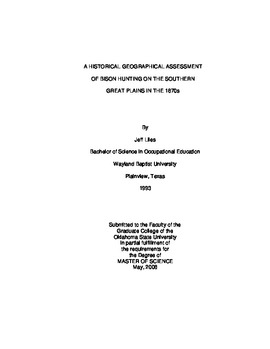| dc.contributor.advisor | Cordova, Carlos | |
| dc.contributor.author | Liles, Jeff | |
| dc.date.accessioned | 2014-04-15T21:46:47Z | |
| dc.date.available | 2014-04-15T21:46:47Z | |
| dc.date.issued | 2008-05-01 | |
| dc.identifier.uri | https://hdl.handle.net/11244/9040 | |
| dc.description.abstract | The trading posts serve as a general proxy for hunting activities during the bison hide hunt on the Southern Great Plains in the 1870s. The trading posts offer more stability than hunters' camps for broad conclusions about the hide hunt, in particular for identifying the areas of the range utilized during the commercial hide hunt. The approach is an improvised blending of eyewitness accounts and multiple digital map layers. The result is a network of information about bison hunting and trading that identifies two clusters of human activity and which implicates bison presence and movements. The sum of what this study reveals in maps, plus what hunters observed first-hand and documented, and what is known of the study area indicate that the movements of bison fit a pattern of localized dispersion strategy rather than long distance seasonal migration. | |
| dc.format | application/pdf | |
| dc.language | en_US | |
| dc.publisher | Oklahoma State University | |
| dc.rights | Copyright is held by the author who has granted the Oklahoma State University Library the non-exclusive right to share this material in its institutional repository. Contact Digital Library Services at lib-dls@okstate.edu or 405-744-9161 for the permission policy on the use, reproduction or distribution of this material. | |
| dc.title | Historical Geographical Assessment Of Bison Hunting on the Southern Great Plains in the 1870s | |
| dc.type | text | |
| dc.contributor.committeeMember | Greiner, Alyson | |
| dc.contributor.committeeMember | Shaw, James | |
| osu.filename | Liles_okstate_0664M_2259.pdf | |
| osu.college | Arts and Sciences | |
| osu.accesstype | Open Access | |
| dc.description.department | Department of Geography | |
| dc.type.genre | Thesis | |
